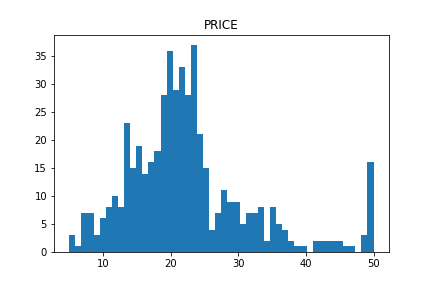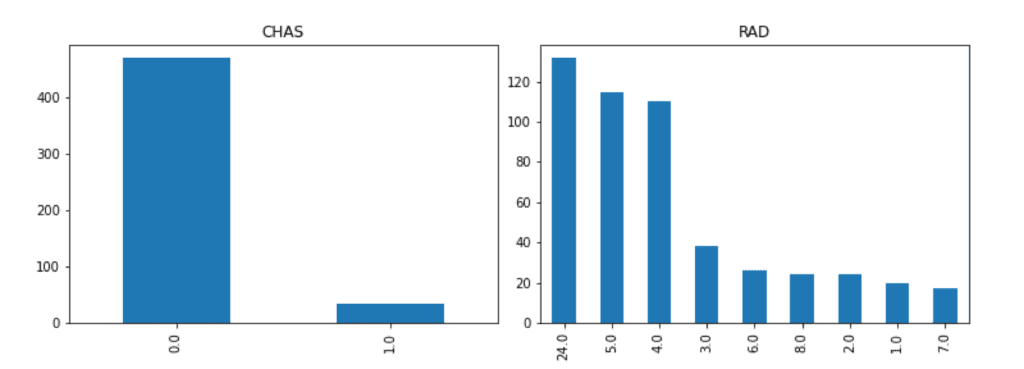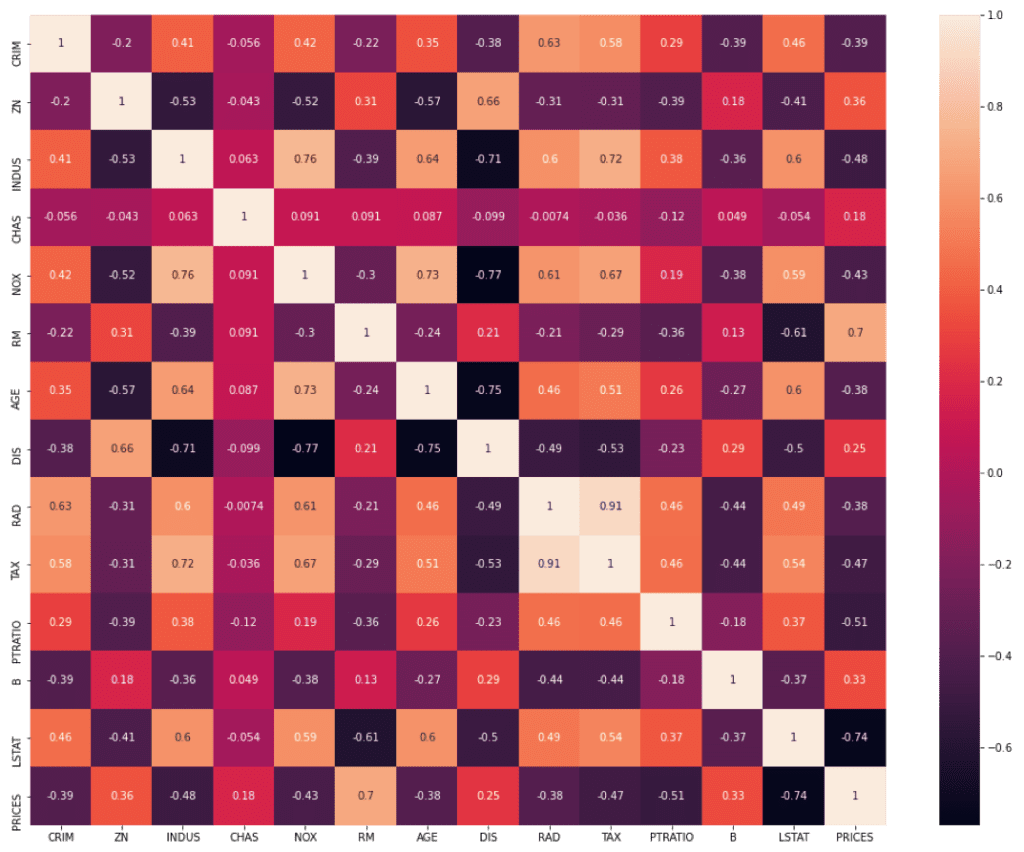Exploratory data analysis(EDA) is one of the most important processes in data analysis. This process is often neglected because it is often invisible in the final code. However, without appropriate EDA, there is no success.
Understanding the nature of the dataset.
This is the purpose of EDA. And then, you will be able to effectively select models and perform feature engineering. This is why EDA is the first step in data analysis.
In this post, we see the basic skills of EDA using the well-known open data set Boston Home Price Dataset as an example.
Prepare the Dataset
For performing EDA, we adopt the Boston house prices dataset, an open dataset for regression analysis. The details of this dataset are introduced in another post.
Import Library
##-- Numpy
import numpy as np
##-- Pandas
import pandas as pd
##-- Scikit-learn
import sklearn
##-- Matplotlib
import matplotlib.pylab as plt
##-- Seaborn
import seaborn as snsLoad the Boston House Prices Dataset from Scikit-learn
It is easy to load this dataset from scikit-learn. Just 2 lines!
from sklearn.datasets import load_boston
dataset = load_boston()The values of the dataset are stored in the variable “dataset”. Note that, in “dataset”, several kinds of information are stored, i.e., the explanatory-variable values, the target-variable values, and the column names of the explanatory-variable values. Then, we have to take them separately as follows.
dataset.data: values of the explanatory variables
dataset.target: values of the target variable (house prices)
dataset.feature_names: the column names
For convenience, we obtain the above data as the Pandas DataFrame type. Pandas is so useful against matrix-type data.
Here, let’s put all the data together into one Pandas DataFrame “f”.
f = pd.DataFrame(dataset.data)
f.columns = dataset.feature_names
f["PRICES"] = dataset.target
f.head()
>> CRIM ZN INDUS CHAS NOX RM AGE DIS RAD TAX PTRATIO B LSTAT PRICES
>> 0 0.00632 18.0 2.31 0.0 0.538 6.575 65.2 4.0900 1.0 296.0 15.3 396.90 4.98 24.0
>> 1 0.02731 0.0 7.07 0.0 0.469 6.421 78.9 4.9671 2.0 242.0 17.8 396.90 9.14 21.6
>> 2 0.02729 0.0 7.07 0.0 0.469 7.185 61.1 4.9671 2.0 242.0 17.8 392.83 4.03 34.7
>> 3 0.03237 0.0 2.18 0.0 0.458 6.998 45.8 6.0622 3.0 222.0 18.7 394.63 2.94 33.4
>> 4 0.06905 0.0 2.18 0.0 0.458 7.147 54.2 6.0622 3.0 222.0 18.7 396.90 5.33 36.2From here, we perform the EDA and understand the dataset!
Summary information
First, we should look at the entire dataset. Information from the whole to the details, this order is important. The “info()” method in Pandas makes it easy to confirm the information of columns, non-null-value count, and its data type.
<class 'pandas.core.frame.DataFrame'>
RangeIndex: 506 entries, 0 to 505
Data columns (total 14 columns):
# Column Non-Null Count Dtype
--- ------ -------------- -----
0 CRIM 506 non-null float64
1 ZN 506 non-null float64
2 INDUS 506 non-null float64
3 CHAS 506 non-null float64
4 NOX 506 non-null float64
5 RM 506 non-null float64
6 AGE 506 non-null float64
7 DIS 506 non-null float64
8 RAD 506 non-null float64
9 TAX 506 non-null float64
10 PTRATIO 506 non-null float64
11 B 506 non-null float64
12 LSTAT 506 non-null float64
13 PRICES 506 non-null float64
dtypes: float64(14)
memory usage: 55.5 KBMissing Values
We have already checked how many non-null-values are. Here, on the contrary, we check how many missing values are. We can check it by the combination of the “isnull()” and “sum()” methods in Pandas.
f.isnull().sum()
>> CRIM 0
>> ZN 0
>> INDUS 0
>> CHAS 0
>> NOX 0
>> RM 0
>> AGE 0
>> DIS 0
>> RAD 0
>> TAX 0
>> PTRATIO 0
>> B 0
>> LSTAT 0
>> PRICES 0
>> dtype: int64Fortunately, there is no missing value! This is because this dataset is created carefully. Note that, however, there are usually many problems we have to deal with a real dataset.
Basic Descriptive Statistics Value
We can calculate the basic descriptive statistics values with just 1 sentence!
f.describe()
>> CRIM ZN INDUS CHAS NOX RM AGE DIS RAD TAX PTRATIO B LSTAT PRICES
>> count 506.000000 506.000000 506.000000 506.000000 506.000000 506.000000 506.000000 506.000000 506.000000 506.000000 506.000000 506.000000 506.000000 506.000000
>> mean 3.613524 11.363636 11.136779 0.069170 0.554695 6.284634 68.574901 3.795043 9.549407 408.237154 18.455534 356.674032 12.653063 22.532806
>> std 8.601545 23.322453 6.860353 0.253994 0.115878 0.702617 28.148861 2.105710 8.707259 168.537116 2.164946 91.294864 7.141062 9.197104
>> min 0.006320 0.000000 0.460000 0.000000 0.385000 3.561000 2.900000 1.129600 1.000000 187.000000 12.600000 0.320000 1.730000 5.000000
>> 25% 0.082045 0.000000 5.190000 0.000000 0.449000 5.885500 45.025000 2.100175 4.000000 279.000000 17.400000 375.377500 6.950000 17.025000
>> 50% 0.256510 0.000000 9.690000 0.000000 0.538000 6.208500 77.500000 3.207450 5.000000 330.000000 19.050000 391.440000 11.360000 21.200000
>> 75% 3.677083 12.500000 18.100000 0.000000 0.624000 6.623500 94.075000 5.188425 24.000000 666.000000 20.200000 396.225000 16.955000 25.000000
>> max 88.976200 100.000000 27.740000 1.000000 0.871000 8.780000 100.000000 12.126500 24.000000 711.000000 22.000000 396.900000 37.970000 50.000000Although each value is important, I think it is worth to focus on “mean” and “std” as a first attention.
We can know the average from “mean” so that it makes it possible to judge a value is higher or lower. This feeling is important for a data scientist.
Next, “std” represents the standard deviation, which is an indicator of how much the data is scattered from “mean”. For example, “std” will be small if each value exists almost average. Note that the variance equals to the square of the standard deviation, and the word “variance” may be more common for a data scientist. It is no exaggeration to say that the information in a dataset is contained in the variance. This is because, for instance, there is no information if all values in “AGE” is 30, indicating no worth to attention!
Histogram Distribution
Data with variance is the data that is worth paying attention to. So let’s actually visualize the distribution of the data. Seeing is believing!
We can perform the histogram plotting by “plt.hist()” in “matplotlib”, a famous library for visualization. The argument “bins” can control the fineness of plot.
for name in f.columns:
plt.title(name)
plt.hist(f[name], bins=50)
plt.show()The distribution of “PRICES”, the target variable, is below. In the right side, we can see the so high-price houses. Note here that considering such a high-price data may get a prediction accuracy worse.

The distributions of the explanatory variables are below. We can see the difference in variance between the explanatory variables.

From the above figure, we can infer that the data of “CHAS” and “RAD” are NOT continuous values. Generally, such data that is not continuous is called a categorical variable.
Be careful when handling the categorical variable values, because there is no meaning in the magnitude relationship itself. For example, when a condominium and a house are represented by 0 and 1, respectively, there is no essential meaning in the magnitude relationship(0 < 1).
For the above reasons, let’s check the categorical variables individually.
We can easily confirm the number of each unique value by the “value_counts()” method in Pandas. The first column is the unique values. The second column is the counted numbers of unique values.
f['RAD'].value_counts()
>> 24.0 132
>> 5.0 115
>> 4.0 110
>> 3.0 38
>> 6.0 26
>> 8.0 24
>> 2.0 24
>> 1.0 20
>> 7.0 17
>> Name: RAD, dtype: int64It is important to check the data visually. It is easy to visualize the counted numbers of unique values for each column.
f['CHAS'].value_counts().plot.bar(title="CHAS")
f['RAD'].value_counts().plot.bar(title="RAD")
Correlation of Variables
Here, we confirm the correlation of variables. The correlation is so important because the higher correlation indicates the higher contribution basically. Conversely, you have the option of removing variables that contribute less. By dropping variables that contribute less, the risk of overfitting is reduced
We can easily calculate the correlation matrix between the variables(or columns) by the “corr()” function in Pandas.
f.corr()
CRIM ZN INDUS CHAS NOX RM AGE DIS RAD TAX PTRATIO B LSTAT PRICES
CRIM 1.000000 -0.200469 0.406583 -0.055892 0.420972 -0.219247 0.352734 -0.379670 0.625505 0.582764 0.289946 -0.385064 0.455621 -0.388305
ZN -0.200469 1.000000 -0.533828 -0.042697 -0.516604 0.311991 -0.569537 0.664408 -0.311948 -0.314563 -0.391679 0.175520 -0.412995 0.360445
INDUS 0.406583 -0.533828 1.000000 0.062938 0.763651 -0.391676 0.644779 -0.708027 0.595129 0.720760 0.383248 -0.356977 0.603800 -0.483725
CHAS -0.055892 -0.042697 0.062938 1.000000 0.091203 0.091251 0.086518 -0.099176 -0.007368 -0.035587 -0.121515 0.048788 -0.053929 0.175260
NOX 0.420972 -0.516604 0.763651 0.091203 1.000000 -0.302188 0.731470 -0.769230 0.611441 0.668023 0.188933 -0.380051 0.590879 -0.427321
RM -0.219247 0.311991 -0.391676 0.091251 -0.302188 1.000000 -0.240265 0.205246 -0.209847 -0.292048 -0.355501 0.128069 -0.613808 0.695360
AGE 0.352734 -0.569537 0.644779 0.086518 0.731470 -0.240265 1.000000 -0.747881 0.456022 0.506456 0.261515 -0.273534 0.602339 -0.376955
DIS -0.379670 0.664408 -0.708027 -0.099176 -0.769230 0.205246 -0.747881 1.000000 -0.494588 -0.534432 -0.232471 0.291512 -0.496996 0.249929
RAD 0.625505 -0.311948 0.595129 -0.007368 0.611441 -0.209847 0.456022 -0.494588 1.000000 0.910228 0.464741 -0.444413 0.488676 -0.381626
TAX 0.582764 -0.314563 0.720760 -0.035587 0.668023 -0.292048 0.506456 -0.534432 0.910228 1.000000 0.460853 -0.441808 0.543993 -0.468536
PTRATIO 0.289946 -0.391679 0.383248 -0.121515 0.188933 -0.355501 0.261515 -0.232471 0.464741 0.460853 1.000000 -0.177383 0.374044 -0.507787
B -0.385064 0.175520 -0.356977 0.048788 -0.380051 0.128069 -0.273534 0.291512 -0.444413 -0.441808 -0.177383 1.000000 -0.366087 0.333461
LSTAT 0.455621 -0.412995 0.603800 -0.053929 0.590879 -0.613808 0.602339 -0.496996 0.488676 0.543993 0.374044 -0.366087 1.000000 -0.737663
PRICES -0.388305 0.360445 -0.483725 0.175260 -0.427321 0.695360 -0.376955 0.249929 -0.381626 -0.468536 -0.507787 0.333461 -0.737663 1.000000Like the above, it is easy to calculate the correlation matrix, however, it is difficult to grasp the tendency with simple numerical values.
In such a case, let’s utilize the heat map function included in “seaborn”, the library for plotting. Then, we can confirm the correlation visually.

Here, we focus on the relationship between “PRICES” – OTHER(“CRIM”, “ZN”, “INDUS”…etc). We can clearly see that “RM” and “LSTAT” are high correlated to “PRICES”.

Summary
So far we have seen how to perform EDA briefly. The purpose of EDA is to properly identify the nature of the dataset. Proper EDA can make it possible to explore the next step effectively, e.g. feature engineering and modeling methods.

